Why Battery Powered Lifts Are Revolutionizing Safe Material Handling
Battery powered lifts are portable, electric lifting devices that use rechargeable batteries to move people, equipment, and materials safely without being plugged into wall power. Here's what you need to know:
Key Types:
- Patient lifts - 400-600 lb capacity for home care and hospitals
- Industrial scissor lifts - 770-2,000 lb capacity for warehouses
- Mortuary lifts - 1,000+ lb capacity for funeral homes
- Stair chairs - 500 lb capacity for emergency evacuation
Main Benefits:
- Portability - No power cords or hydraulic lines needed
- Zero emissions - Clean operation indoors and outdoors
- Reduced injuries - Eliminates manual lifting strain
- Quiet operation - Battery motors run nearly silent
The shift toward battery power is driven by safety regulations, ergonomic requirements, and the need for flexible equipment that works anywhere. As one tree care professional noted: "Once you start a chain saw or chipper, there goes your quiet" - but battery lifts maintain noise-free operation.
From patient transfers in hospitals to casket handling in funeral homes, these lifts are becoming essential tools for protecting workers while maintaining dignity and independence for users.
I'm from American Mortuary Coolers, and we've helped funeral professionals nationwide select the right battery powered lifts for their specific space and capacity needs. Our experience with mortuary equipment has shown us how the right lift can transform both safety and efficiency in sensitive environments.
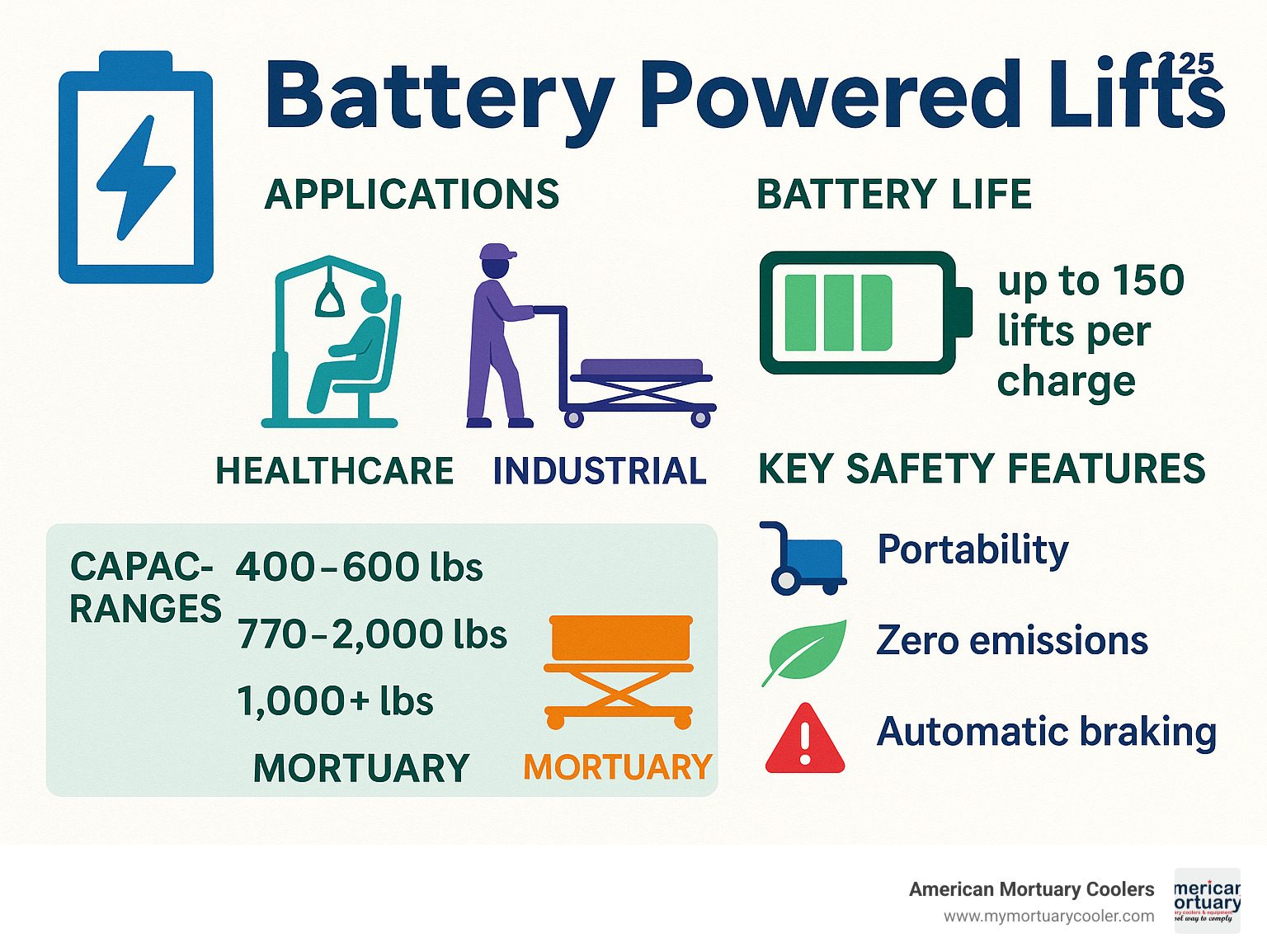
Understanding Battery Powered Lifts
Think of battery powered lifts as the cordless drills of the lifting world - they go wherever you need them without being tethered to a wall outlet. These electric lifting devices use rechargeable battery packs to power electrical actuators, giving you the freedom to lift people, equipment, and materials anywhere.
The real magic happens in the battery technology. Lithium-ion batteries are the premium choice, offering thousands of charge cycles and superior performance. AGM (Absorbed Glass Mat) batteries provide a more budget-friendly option while still delivering reliable power for most everyday applications.
What sets these lifts apart is their triple threat of benefits: portability (no cords to trip over), zero emissions (clean indoor air), and noise reduction (your neighbors will thank you). Whether you're in a hospital room, warehouse, or funeral home preparation area, these lifts work quietly and cleanly.
How Do Battery Powered Lifts Work?
The beauty of battery powered lifts lies in their straightforward operation. Electric motors drive the lifting mechanism through gear reduction systems, all controlled by a handheld pendant or integrated control panel. Most systems run on 24V or 36V systems for optimal safety and efficiency.
Your control pendant becomes your command center, featuring simple up/down buttons, emergency stops, and battery level indicators. Modern units include waterproof pendants for bath lifts and navigation lights for stair chairs used in dimly lit areas.
The onboard charger makes life simple - just plug into any standard 120V outlet for overnight charging. Smart safety cut-off features prevent operation when battery power drops too low, ensuring you never get stuck mid-lift.
Battery Technology & Runtime Essentials
Battery performance varies based on what you're asking it to do. Bath lifts typically provide 7-12 lifts per charge, depending on user weight and maintenance. Industrial lifts are workhorses designed to handle a full 8-hour industrial shift with normal use.
Lithium-ion batteries are the marathon runners of the battery world. They handle thousands of cycle lifespan compared to hundreds for traditional batteries. Yes, they cost more upfront, but they're like buying quality boots - they'll serve you longer. Fast-charge capabilities mean less downtime between uses.
AGM batteries offer solid performance without breaking the bank. They're perfect for bath lifts and lighter-duty applications where you need reliability but don't require the extreme longevity of lithium-ion.
Primary Users & Everyday Use Cases
Battery powered lifts serve an amazingly diverse group of people solving real-world challenges every day. Home caregivers rely on portable patient lifts to safely transfer loved ones without throwing out their backs. Hospitals integrate these lifts into Safe Patient Handling programs, while warehouses use them to move heavy materials efficiently.
Tree-care professionals love them because they provide full-day power while meeting strict noise regulations in residential neighborhoods. Vehicle garages use them for lifting heavy components, and funeral homes - our specialty area - depend on them for respectful, quiet handling in sensitive environments.
At American Mortuary Coolers, we understand that each application has unique requirements, and the right battery-powered lift can transform both safety and efficiency in your specific environment.
Main Types of Battery Powered Lifts
When it comes to battery powered lifts, there's truly a solution for every lifting challenge you might face. From helping someone out of a bathtub to moving heavy equipment in a warehouse, these lifts have evolved to meet specific needs across different industries.
The main categories include scissor tables for industrial use, patient lifts for healthcare settings, bath lifts for home independence, stair and vehicle lifts for mobility, and specialized lifts for mortuary and EV battery handling.
Patient & Home-Care Battery Powered Lifts
Patient lifts have become game-changers for families caring for loved ones at home. These floor-to-stand devices, like the IndeeLift series, can handle 400-600 lb capacities while staying compact enough to store in a closet when not needed.
What makes these lifts special is their fall recovery capability. Instead of calling 911 every time someone falls, families can safely help their loved one back to standing or seated position. This preserves dignity while avoiding expensive emergency room visits.
Sit-to-stand chairs offer a middle ground between full patient lifts and basic mobility aids. The SitnStand portable lift chair supports up to 400 lbs and runs for 4-7 days between charges. Users tell us these devices give them back their confidence and independence.
The real benefit here is caregiver safety. Back injuries from lifting are incredibly common among family caregivers and healthcare workers. These battery-powered lifts eliminate the dangerous manual lifting that causes so many injuries.
Bath Lifts: Staying Independent in the Tub
Bath lifts represent one of the most successful uses of battery power in home care. Most modern units use rechargeable lithium-ion batteries stored in waterproof floating pendants, delivering 7-12 lifts per charge.
You'll find two main backrest styles: recline vs rigid. Auto-recline models are great for relaxation but might not fit tall users in standard tubs. Rigid designs maximize legroom, while manual recline backrests give you more control over positioning.
Most battery-powered bath lifts handle up to 300 lb capacity. Deep-soaker models can reach up to 19" in height, while the lowest models descend to about 2.3" for easy entry. The safety feature that prevents lowering when battery power is low is crucial - it keeps users from getting trapped in the tub.
The waterproof hand pendant is what makes these lifts so user-friendly. You control everything from the comfort of your bath without worrying about water damage. For detailed guidance on selecting the right model, check out How to choose a bath lift.
Industrial & Scissor Lift Tables
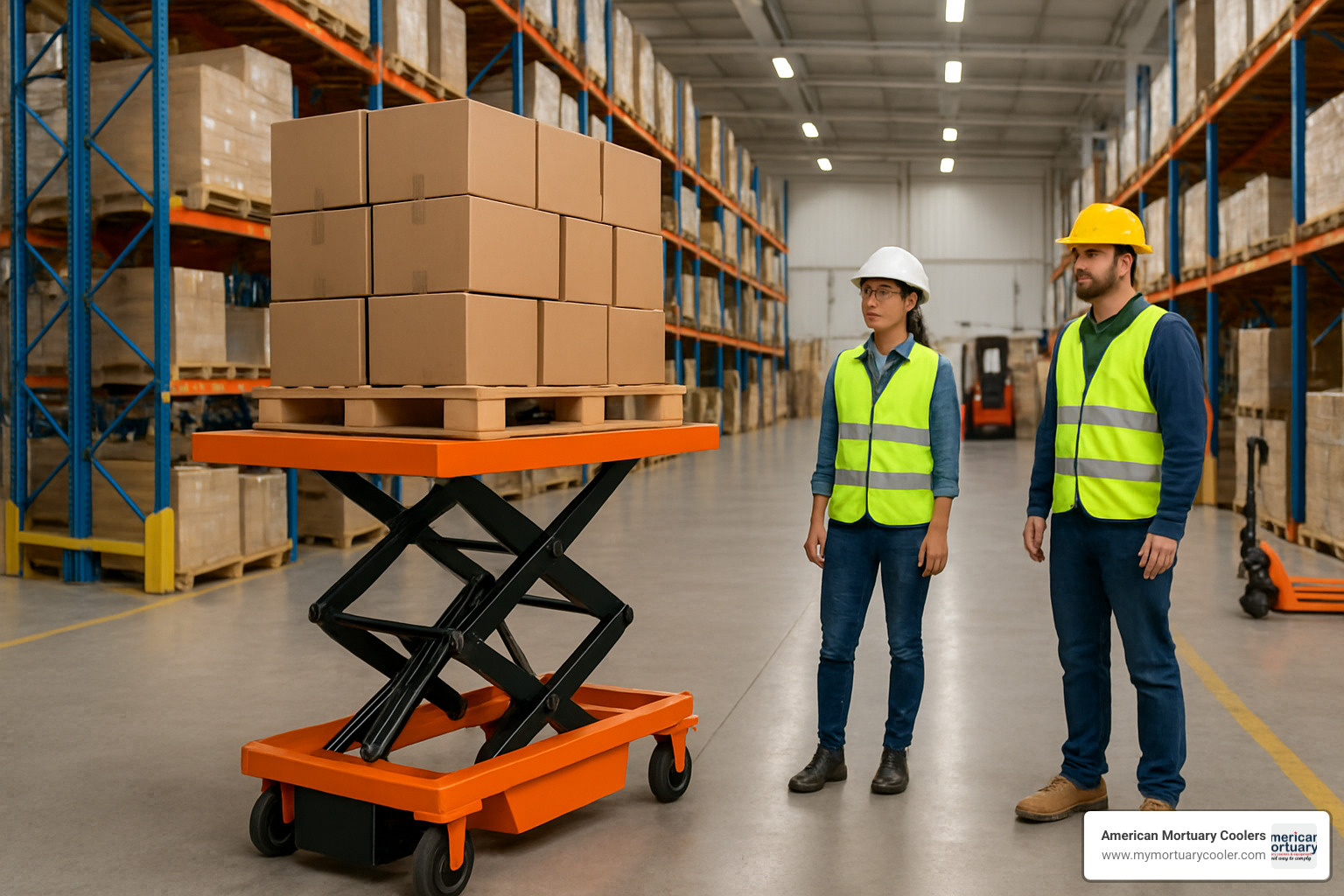
Industrial battery powered lifts are the workhorses of warehouses and manufacturing facilities. These scissor lift tables handle anywhere from 770-2,000 lb capacity, with mobile cart designs that can follow the work wherever it goes.
Double-scissor configurations give you extended lift ranges while keeping the platform stable. The Makinex Powered Hand Truck lifts up to 309 lbs and raises to 6 feet - perfect for loading boxes into delivery vans without straining your back.
What's brilliant about battery power in industrial settings is the freedom it provides. No more dragging extension cords or worrying about hydraulic line placement. Just plug in overnight on standard 110-volt outlets, and you're ready for the next shift.
These lifts excel in loading applications, from warehouse-to-vehicle transfers to production line positioning. For workplace accommodation needs, Battery Powered Lift Tables provides detailed vendor comparisons and specifications.
Vehicle, Stair & Mobility Lifts
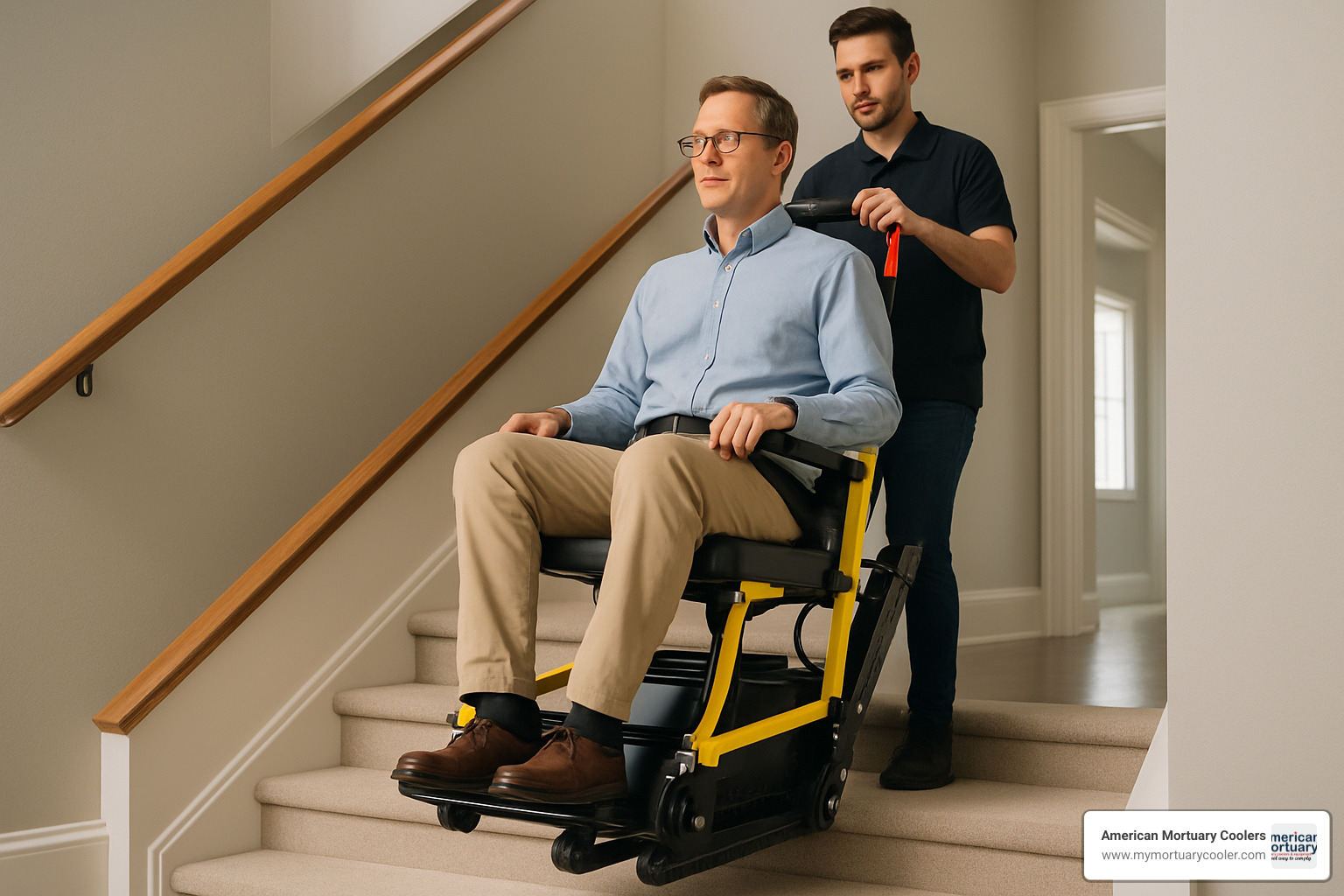
Stair chairs are critical safety equipment for emergency evacuation and daily mobility challenges. The MOBI EZ Battery Powered Stair Chair supports 500 lb capacity with a single charge providing 1.5 hours runtime - that's approximately 30 trips up five-story buildings.
Navigation lights make these chairs invaluable for dark stairwells, while three speed settings let you adjust for different stair angles and user weights. This flexibility proves essential during emergency evacuations when conditions vary dramatically.
Hitch scooter lifts like the Harmar AL100 require no modifications to mobility devices while protecting them from weather and road debris. Platform lifts can handle up to 750 lbs and elevations up to 4 feet, making them ideal when ramps simply won't work.
Specialized Mortuary & EV Battery Lifts
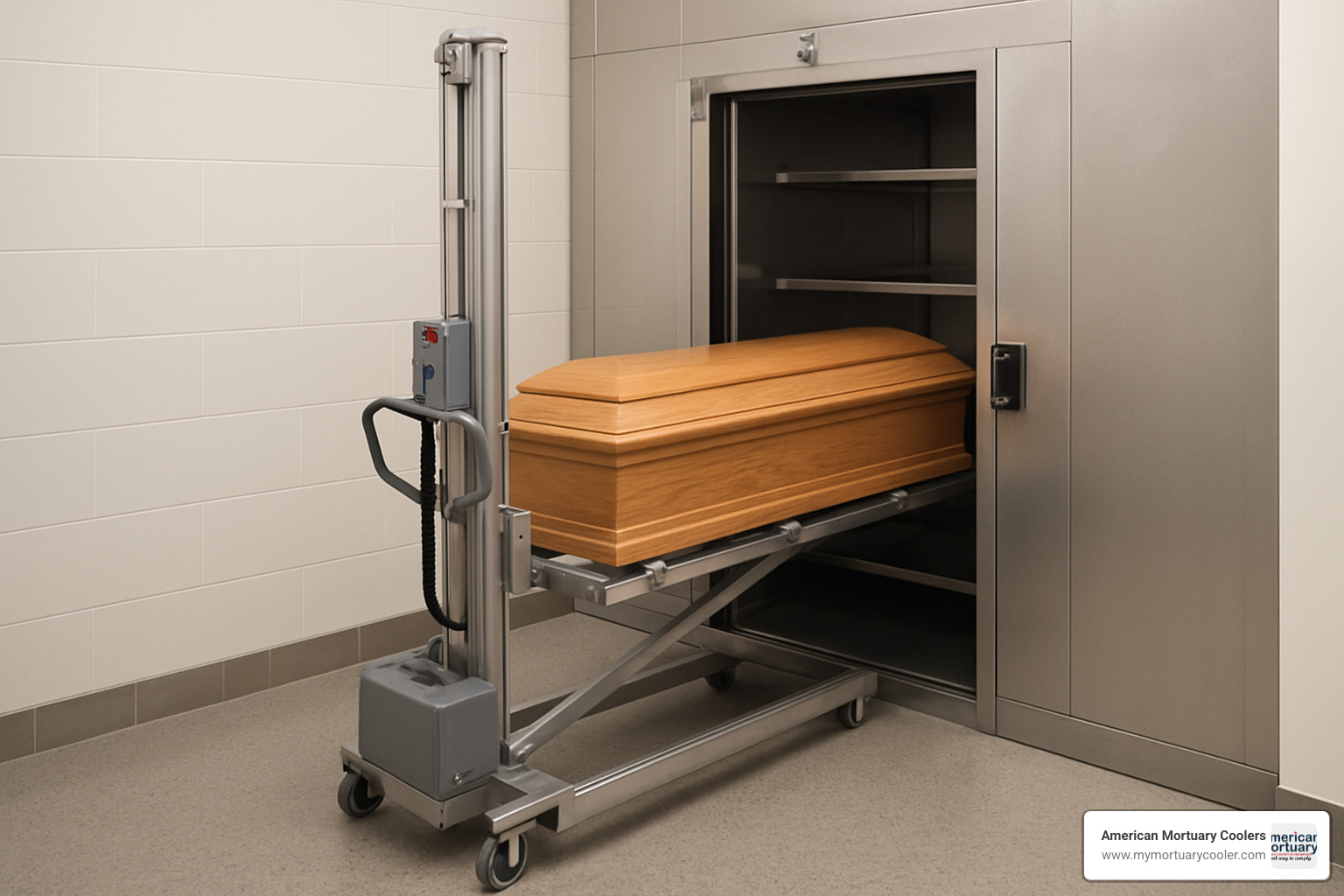
Mortuary applications require specialized features for dignity, safety, and regulatory compliance. Battery-powered mortuary lifts typically support 1,000+ lb capacity with low-profile designs for easy loading into coolers and transport vehicles.
Marine-grade aluminum construction resists corrosion while keeping the lift weight manageable - some units weigh just 395 lbs while supporting 1,000 lbs. Telescoping masts allow precise positioning at desired heights, while reversible forks accommodate different casket and container types.
Electric actuators eliminate hydraulic fluids, reducing maintenance headaches and leakage risks in sensitive funeral home environments. This is particularly important when working around families during their most difficult times.
EV battery handling represents an emerging application as electric vehicles become more common. The C&C Power Batt-Lift handles specific UPS battery models with 1,500 lb capacity, designed for one-person operation in tight service bay aisles.
Key Features & Buying Checklist for Battery Powered Lifts
When you're shopping for battery powered lifts, it's easy to get overwhelmed by all the options. Let me walk you through what really matters so you can make a confident choice.
Weight capacity should be your starting point, but don't just look at today's needs. If you're buying a patient lift for an aging parent, consider that mobility challenges often increase over time. A lift rated for 450 lbs might serve you better than one maxed out at 300 lbs.
The lift range needs to match your specific situation perfectly. Patient lifts like the Invacare RPL450-1 offer a 24" to 74" range, which works beautifully for most bed-to-wheelchair transfers. But if you're dealing with higher beds or lower seating, double-check those measurements before buying.
Battery life can make or break your experience with these lifts. Bath lifts averaging 7-12 cycles per charge work great for most families, but if you're caring for someone who bathes daily, you'll want to stay on the higher end of that range. Industrial applications need equipment that can handle a full 8-hour shift without dying mid-lift.
Charge time affects how you'll use the lift day-to-day. Most units charge overnight on standard household current, which works perfectly if you can plan ahead. But some newer models offer fast-charge options that can be lifesavers when you forgot to plug in the night before.
Don't overlook portability features like wheel quality and handle placement. The difference between smooth-rolling wheels and cheap ones becomes obvious the first time you're maneuvering a 400-lb patient lift across carpet.
Safety sensors and emergency features aren't optional extras - they're essential protection. Anti-entrapment systems stop the lift if something gets caught, while emergency lowering capabilities ensure you're never stranded if the battery dies unexpectedly.
The warranty terms tell you a lot about manufacturer confidence in their product. Look for companies that stand behind their lifts with comprehensive coverage, not just basic parts warranties.
When calculating total cost of ownership, factor in battery replacement cycles, maintenance requirements, and potential repair costs. A cheaper lift that needs frequent service calls isn't really saving you money.
For detailed comparisons of different lift technologies and their long-term costs, check out our guide on comparing battery powered lift tables - it breaks down the real-world performance differences you need to know.
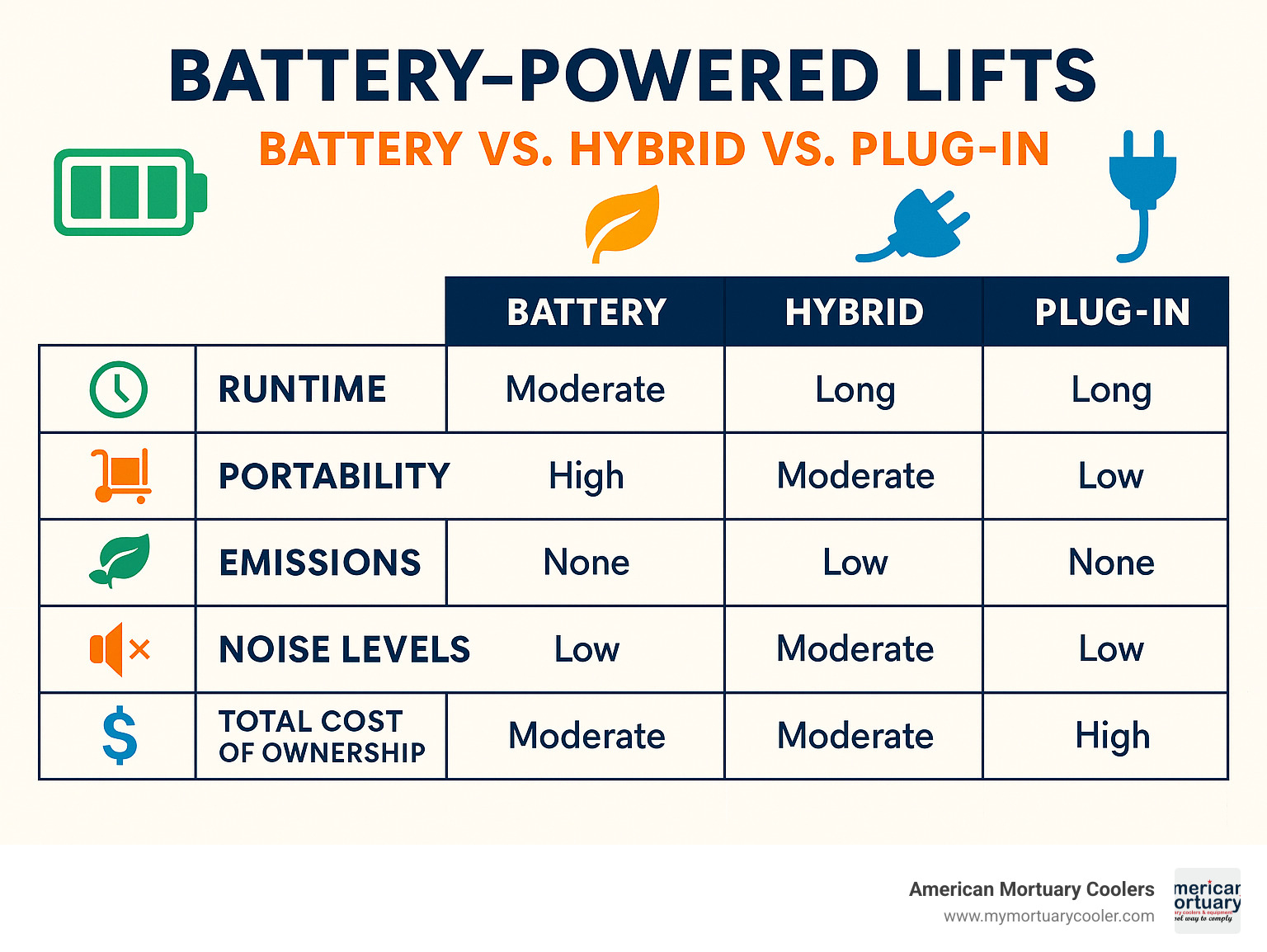
Must-Have Safety & Ergonomic Features
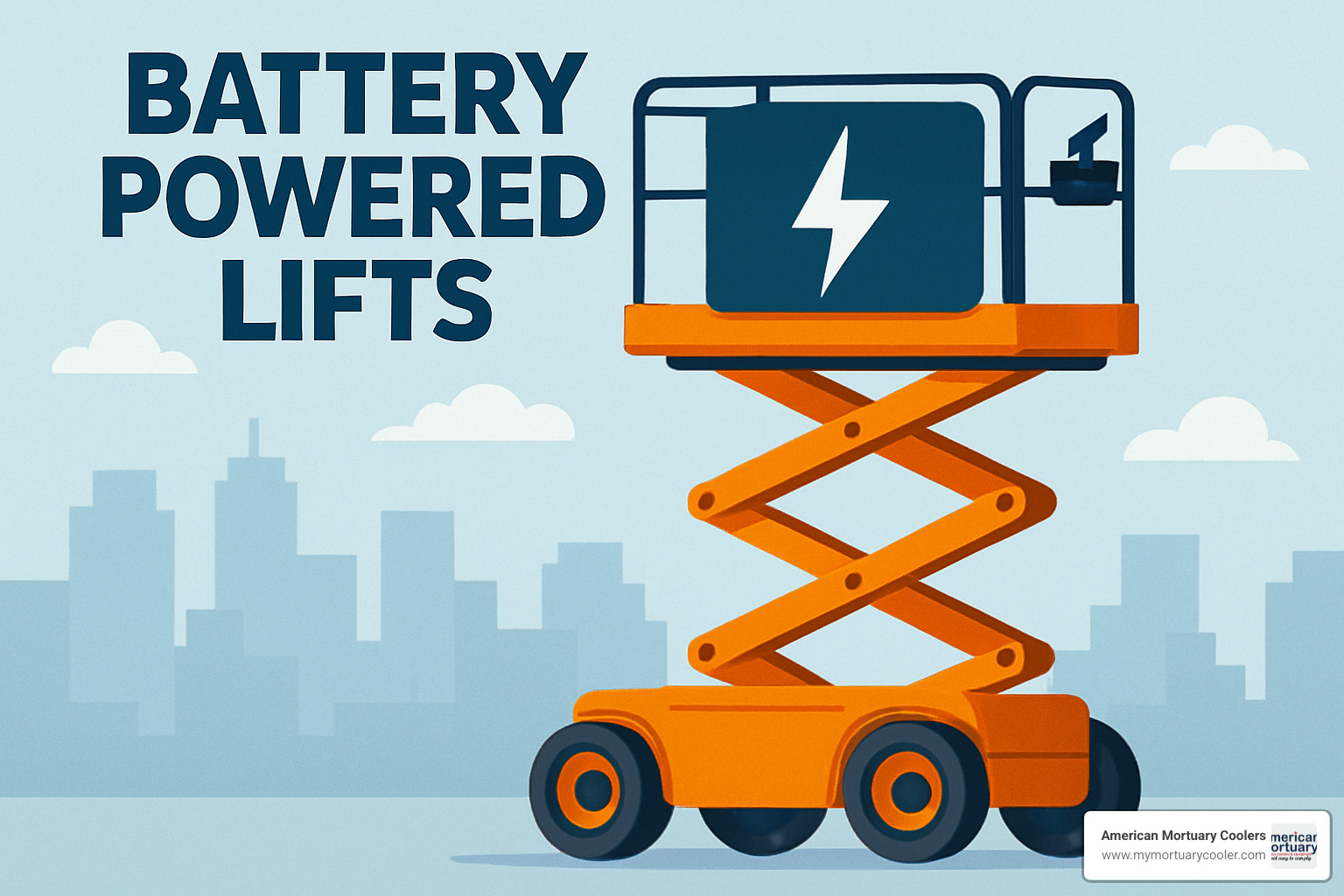
Safety features in battery powered lifts aren't just nice-to-have extras - they're the difference between confidence and fear every time you use the equipment.
Anti-entrapment technology represents the gold standard for patient lifts. These smart systems automatically stop and reverse if they detect unexpected resistance, preventing injuries from pinching or crushing.
Harness systems need to distribute weight safely while keeping users comfortable and dignified. Cross-style chest harnesses work beautifully for stair chairs, giving secure support without feeling restrictive. Patient lifts use padded slings that cradle users gently - proper fit and easy adjustment mechanisms make all the difference.
Overload cut-off protection saves equipment and prevents injuries when weight limits get exceeded. The best systems give you visual and audible warnings before reaching critical limits, so you can adjust safely rather than dealing with emergency shutdowns.
Ergonomic push handles at the right height protect operators from back strain. Intuitive controls reduce training time and mistakes, while padded swivel bars with 360-degree rotation make patient transfers smoother and more comfortable.
Emergency stop buttons must be easily accessible and clearly marked. Those big red buttons provide universal recognition, and pendant-mounted stops ensure operators maintain control during every phase of operation.
Budget & Financing Considerations
The price range for battery powered lifts might surprise you - we're talking anywhere from $500 for basic bath lifts up to $10,000+ for specialized industrial units. The SitnStand portable lift chair comes in at $599, while the IndeeLift FTS-600 reaches $3,695.
Rental versus purchase depends on how often you'll use the equipment and your budget reality. Short-term needs often make rental the smart choice, while regular use justifies purchase through lower long-term costs.
Tax credits may apply for qualifying equipment, especially in healthcare and accessibility applications. Some areas offer up to 50% tax credits on capital equipment investments, which can dramatically improve your return on investment calculations.
Lifecycle battery costs deserve serious consideration beyond that initial sticker price. Lithium-ion batteries cost more upfront but deliver thousands of charge cycles compared to hundreds for traditional batteries. This longevity often provides better total cost of ownership despite the higher initial investment.
At American Mortuary Coolers, we've helped funeral professionals across the country steer these decisions. The right lift transforms both safety and efficiency, but only if it matches your specific needs and budget reality.
Maintenance, Safety & Regulatory Considerations
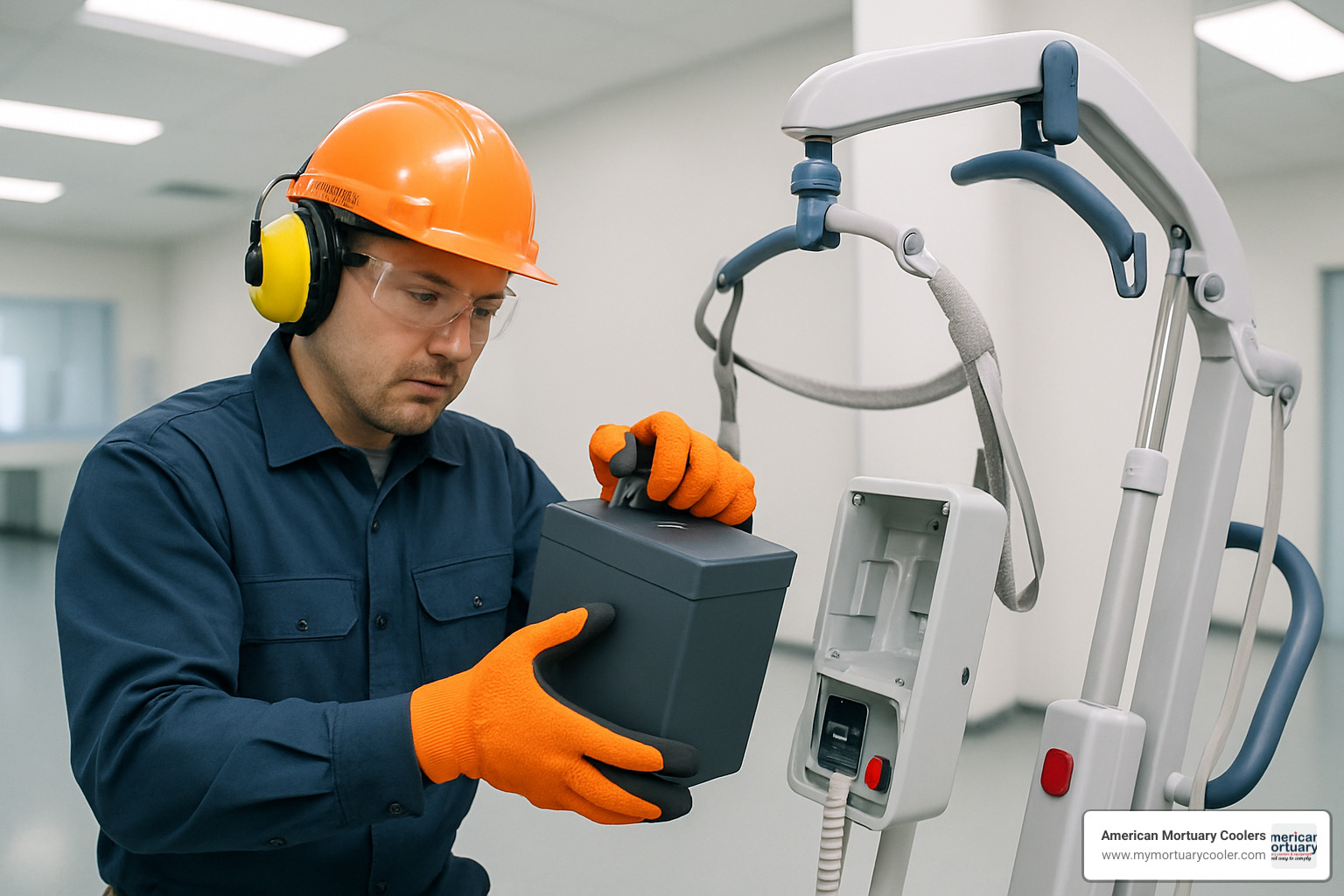
Taking care of your battery powered lifts isn't complicated, but it makes all the difference in how long they'll serve you reliably. Think of it like caring for a car - a little attention goes a long way.
Daily inspections should become second nature. A quick visual check for obvious damage, loose connections, or warning lights takes just a minute but can prevent serious problems. Check that battery charge indicator too - you don't want to find a dead battery when you need the lift most.
Monthly charging routines keep batteries healthy and extend their working life. The key is avoiding those deep discharge cycles that stress the battery chemistry. Instead, plug in your lift after each use rather than waiting until it's completely drained.
Temperature matters more than most people realize. Cold-weather storage in unheated garages or sheds can permanently damage battery chemistry. We've seen funeral homes lose expensive batteries to freezing temperatures that could have been prevented with simple indoor storage.
Battery replacement cycles depend heavily on how well you treat them. Lithium-ion batteries can last 3-5 years with proper care, while AGM batteries typically need replacement every 1-3 years. Plan these costs into your budget.
The regulatory landscape varies significantly by industry. OSHA guidelines apply to workplace lifting equipment, while FDA regulations cover medical devices like patient lifts. ANSI/ALI standards provide safety benchmarks for automotive lifts. California's zero-emission mandates increasingly favor battery power over gas engines, and other states are following suit.
Extending Battery & Equipment Life
The secret to long battery life starts with proper charging practices. Use the manufacturer's specified chargers - those cheap aftermarket chargers might save money upfront but can destroy expensive batteries. Modern onboard chargers handle most of the work automatically, but older units need more attention.
Avoiding deep discharge protects your investment. Most systems include safety cutoffs that prevent operation when battery levels drop too low, but regular charging keeps you from ever reaching those limits. It's much better to top off frequently than to run batteries down completely.
Climate-controlled storage protects both batteries and mechanical components. Extreme temperatures and humidity are the enemies of electronic equipment. Freezing can crack battery cases, while high heat accelerates chemical breakdown and reduces capacity.
Firmware updates might sound technical, but they can improve charging algorithms and add safety features to newer lifts. Check with your manufacturer periodically - some updates require professional service, but others are surprisingly simple to install yourself.
Spill-free designs in modern lifts protect sensitive electronics from moisture and chemical exposure. Sealed battery compartments and waterproof control pendants make equipment last longer in demanding environments.
From our experience at American Mortuary Coolers, the funeral homes that take maintenance seriously get years more service from their equipment. It's not just about saving money - it's about having reliable equipment when you need it most.
Frequently Asked Questions about Battery Powered Lifts
How long does a battery powered lift run on a single charge?
The answer depends entirely on what type of lift you're using and how hard you're working it. Bath lifts typically give you 7-12 lifts per charge, which translates to about a week of normal use for most people.
Industrial lifts are built for the long haul, designed to power through full 8-hour shifts without breaking a sweat. If you're in emergency services, the MOBI EZ stair chair delivers 1.5 hours of continuous runtime - that's roughly 30 trips up five flights of stairs before needing a plug-in break.
For home care, the SitnStand chair is remarkably efficient, lasting 4-7 days between charges with typical daily use. The heavier-duty IndeeLift models handle multiple 400 lb lifts per charge, though they'll need more frequent charging than their lighter-duty cousins.
Here's the reality check: battery age matters. That shiny new lithium-ion battery delivers peak performance, but like all of us, it slows down over time. After thousands of charge cycles, you'll notice shorter runtime. Plan for this gradual decline and budget for eventual battery replacement.
What are the main limitations or disadvantages of battery powered lifts?
Let's be honest - battery powered lifts aren't perfect. The biggest trade-off is weight. Batteries are heavy, and that adds bulk compared to manual lifts. The good news? That extra weight often improves stability and performance.
Charging discipline becomes part of your routine. Forget to plug in your lift, and you might find yourself with expensive equipment that won't budge when you need it most. It's like your phone - great when charged, useless when dead.
Weather can be a challenge. Cold temperatures sap battery power faster than you'd expect, and some lifts need heating systems for reliable winter operation. Hot weather isn't kind either - it ages batteries faster and can trigger thermal shutdowns.
The upfront cost typically runs higher than manual alternatives. You're paying for the convenience and safety benefits, but the initial investment can sting. Factor in the complexity of electrical systems, which need more sophisticated maintenance than simple mechanical lifts.
Performance degrades over time as batteries age. What starts as all-day runtime gradually becomes half-day, then quarter-day operation. It's predictable, but it means ongoing replacement costs that manual lifts don't have.
How do battery powered lifts reduce caregiver injury risk?
This is where battery powered lifts truly shine. They eliminate manual lifting - the number one cause of caregiver back injuries. The IndeeLift series transforms what used to be a dangerous two-person manual lift into safe, one-person powered assistance.
Ergonomic design keeps caregivers in natural, comfortable positions. Handles sit at proper heights, controls fall naturally under your fingers, and the equipment does the heavy work while you provide guidance and support. No more awkward bending, twisting, or straining.
Consistent performance might be the most overlooked benefit. Manual lifting gets harder as you get tired - that's when injuries happen. Battery power delivers the same reliable assistance whether it's your first lift of the day or your fifteenth.
SPHM programs (Safe Patient Handling and Mobility) increasingly require mechanical lifting aids to protect healthcare workers. Battery-powered lifts make these programs practical by providing real alternatives to dangerous manual lifting.
At American Mortuary Coolers, we've seen funeral professionals transform their daily operations with the right battery lifts. The difference isn't just in reduced injuries - it's in the confidence and peace of mind that comes from knowing you can handle any situation safely and with dignity.
Conclusion
The world of battery powered lifts has truly arrived, and it's changing everything about how we handle lifting challenges safely and with dignity. Whether you're helping a loved one maintain independence at home, managing warehouse operations, or providing compassionate funeral services, these remarkable devices offer solutions that seemed impossible just a few years ago.
What excites me most about this technology is how it keeps getting better. Lithium-ion batteries now last thousands of charge cycles while charging faster than ever. Smart controls are adding safety features that protect users in ways we never thought possible. And with zero-emission requirements spreading across the country, battery power isn't just preferred anymore - it's often required.
Here at American Mortuary Coolers, we've had the privilege of working with funeral professionals across Tennessee, Atlanta, Chicago, and throughout the nation. Time and again, we've witnessed how the right lift transforms not just safety protocols, but the entire experience for families during their most difficult moments.
The secret to success lies in matching the right lift to your specific needs. A 300-pound bath lift won't work for industrial applications, just like a 2,000-pound scissor lift is overkill for home patient care. Think about your weight capacity requirements with a comfortable safety margin. Consider how battery life fits your daily routine. Most importantly, never compromise on safety features that protect everyone involved.
The financial investment in quality battery powered lifts pays for itself through fewer worker injuries, better productivity, and the priceless benefit of preserving dignity for those we serve. As workplace safety regulations get stricter and environmental protection becomes non-negotiable, these lifts aren't just nice to have - they're becoming essential equipment.
For our funeral industry colleagues who need specialized guidance, we've put together comprehensive insights in our guide on choosing the best mortuary lift system. It covers everything from capacity planning to safety considerations specific to funeral service environments.
Looking ahead, I'm confident that battery powered lifts represent exactly where our industry is heading. They combine the power we need, the portability we want, and the protection we must have. Most importantly, they support something we all believe in - helping people maintain their independence and dignity, no matter what challenges they face.


















